 W
WThe McDonnell ADM-20 Quail was a subsonic, jet powered, air-launched decoy cruise missile built by McDonnell Aircraft Corporation. The Quail was designed to be launched by the Boeing B-52 Stratofortress strategic bomber and its original United States Air Force designation was GAM-72.
 W
WBLU-43/B and BLU-44/B "Dragontooth" were air-dropped cluster-type land mines used by the United States during the Vietnam War. It is chemically activated and has a relatively low explosive content, typically maiming rather than killing.
 W
WThe M-28 or M-29 Davy Crockett Weapon System was the tactical nuclear recoilless smoothbore gun for firing the M388 nuclear projectile armed with the W54 nuclear warhead that was deployed by the United States during the Cold War. It was the first and at the time was the utmost important project assigned to the United States Army Weapon Command in Rock Island, Illinois. It was one of the smallest nuclear weapon systems ever built, with a yield of 20 tonnes of TNT (84 GJ). It is named after American folk hero, soldier, and congressman Davy Crockett.
 W
WENTAC or MGM-32A was a French MCLOS wire-guided Anti-tank missile. Developed in the early 1950s, the weapon entered service with the French army in 1957. Production ended in 1974 after approximately 140,000 had been built.
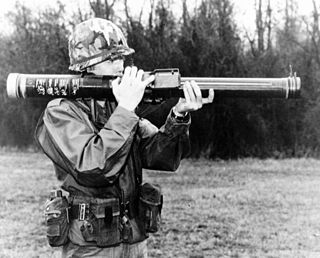 W
WThe FGR-17 Viper was an American one-man disposable antitank rocket, which was slated in the 1980s to be the replacement for the M72 LAW, but was canceled shortly after production began because of cost overruns and concerns about safety and capability.
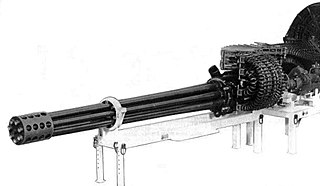 W
WThe General Electric GAU-8/A Avenger is a 30 mm hydraulically driven seven-barrel Gatling-style autocannon that is typically mounted in the United States Air Force's Fairchild Republic A-10 Thunderbolt II. Designed specifically for the anti-tank role, the Avenger delivers very powerful rounds at a high rate of fire. The GAU-8/A is also used in the Goalkeeper CIWS ship weapon system, which provides defense against short-range threats such as highly maneuverable missiles, aircraft, and fast maneuvering surface vessels. The GAU-8/A is currently produced by General Dynamics.
 W
WThis is a historic (index) list of U.S. Army weapons and materiel, by their Standard Nomenclature List (SNL) group and individual designations — an alpha-numeric nomenclature system used in the U.S. Army Ordnance Corps Supply Catalogues used from about 1930 to about 1958. The July 1943 Ordnance Publications For Supply Index – OPSI – (page2) explains that the "Index of Standard Nomenclature Lists (...) covers – by groups, and subdivisions of groups – all classes of equipment and supplies, assigned to the Ordnance Department for procurement, storage, issue, and maintenance." The designations in this Wikipedia list represent so-called "major items". For each of the major items, there were separate, designated "Standard Nomenclature Lists" — extensive parts catalogs for supply and repair purposes.
 W
WThe LGM-30 Minuteman is a U.S. land-based intercontinental ballistic missile (ICBM), in service with the Air Force Global Strike Command. As of 2021, the LGM-30G Minuteman III version is the only land-based ICBM in service in the United States and represents the land leg of the U.S. nuclear triad, along with the Trident submarine-launched ballistic missile (SLBM) and nuclear weapons carried by long-range strategic bombers.
 W
WThe M18 recoilless rifle is a 57 mm shoulder-fired, anti-tank recoilless rifle that was used by the U.S. Army in World War II and the Korean War. Recoilless rifles are capable of firing artillery-type shells at reduced velocities comparable to those of standard cannon, but with greater accuracy than anti-tank weapons that used unguided rockets, and almost entirely without recoil. The M18 was a breech-loaded, single-shot, man-portable, crew-served weapon. It could be used in both anti-tank and anti-personnel roles. The weapon could be both shoulder fired or fired from a prone position. The T3 front grip doubled as an adjustable monopod and the two-piece padded T3 shoulder cradle could swing down and to the rear as a bipod for the gunner. The most stable firing position was from the tripod developed for the water-cooled Browning M1917 machine gun.
 W
WThe M20 recoilless rifle is a U.S. 75 mm caliber recoilless rifle T21E12 that was used during the last months of the Second World War and extensively during the Korean War. It could be fired from an M1917A1 .30 caliber machine gun tripod, or from a vehicle mount, typically a Jeep. Its shaped charge warhead, also known as HEAT, was capable of penetrating 100 mm of armor. Although the weapon proved ineffective against the T-34 tank during the Korean War and most other tanks, it was used primarily as a close infantry support weapon to engage all types of targets including infantry and lightly armored vehicles. The M20 proved useful against pillboxes and other types of field fortifications. Its poor armor penetration by the HEAT round was because of it being a spin-stabilized projectile rather than the later fin-stabilized rounds used in the 106mm M40 recoilless rifle.
 W
WThe M40 recoilless rifle is a portable, crew-served 105 mm recoilless rifle made in the United States. Intended primarily as an anti-tank weapon, it could also be employed in an antipersonnel role with the use of an antipersonnel-tracer flechette round. The bore was commonly described as being 106 mm caliber but is in fact 105 mm; the 106 mm designation was intended to prevent confusion with incompatible 105 mm ammunition from the failed M27. The air-cooled, breech-loaded, single-shot rifle fired fixed ammunition and was used primarily from a wheeled ground mount. It was designed for direct firing only, and sighting equipment for this purpose was furnished with each weapon, including an affixed spotting rifle.
 W
WThe M67 recoilless rifle is a 90 mm anti-tank recoilless rifle made in the United States and later in South Korea. It could also be employed in an anti-personnel role with the use of the M590 antipersonnel round. It was designed to be fired primarily from the ground using the bipod and monopod, but could also be fired from the shoulder using the folded bipod as a shoulder rest and the monopod as a front grip. The weapon was air-cooled and breech-loaded, and fired fixed ammunition. It is a direct fire weapon employing stadia lines to allow simple range finding, based on a typical tank target bridging the lines once in range.
 W
WThe M85 is a heavy machine gun firing .50 BMG ammunition that was used primarily for turreted applications in armored fighting vehicles. It was intended to replace the venerable M2 machine gun with a smaller and much lighter weapon, suitable for use inside fighting vehicles, as opposed to only on external mounts. It was used on the M60 series of tanks and the LVTP-7 amphibious landing vehicle.
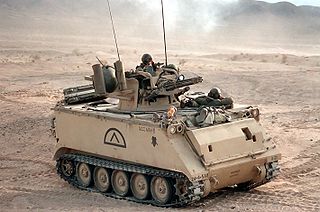 W
WThe M163 Vulcan Air Defense System (VADS) is a self-propelled anti-aircraft gun (SPAAG) that was used by the United States Army. The M168 gun is a variant of the General Dynamics 20 mm M61 Vulcan rotary cannon, the standard cannon in most U.S. combat aircraft since the 1960s, mounted on either an armored vehicle or a trailer.
 W
WThe M242 Bushmaster chain gun is a 25 mm (25×137mm) single-barrel chain-driven autocannon. It is used extensively by the U.S. military, such as in the Bradley fighting vehicle, as well as by other NATO members and some other nations in ground combat vehicles and various watercraft. It was designed and manufactured originally by Hughes Helicopters in Culver City, California. The company was acquired by McDonnell Douglas Helicopters in 1985, which merged into Boeing Corporation in 1997. In 2002, it was sold again to Alliant Techsystems, which merged with Orbital Sciences Corporation in 2015 to form Orbital Science ATK and was, in turn, bought out by Northrop Grumman in 2018. As of 2019, it is produced by Northrop Grumman Innovation Systems.
 W
WThe Mark 37 torpedo is a torpedo with electrical propulsion, developed for the US Navy after World War II. It entered service with the US Navy in the early 1950s, with over 3,300 produced. It was phased out of service with the US Navy during the 1970s, and the stockpiles were sold to foreign navies.
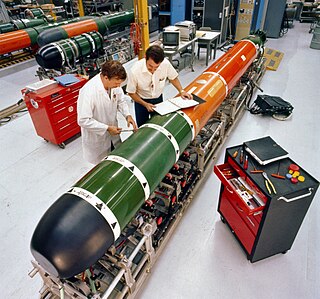 W
WThe Mark 48 and its improved Advanced Capability (ADCAP) variant are American heavyweight submarine-launched torpedoes. They were designed to sink deep-diving nuclear-powered submarines and high-performance surface ships.
 W
WThe Mark 60 CAPTOR is the United States' only deep-water anti-submarine naval mine. It uses a Mark 46 torpedo contained in an aluminum shell that is anchored to the ocean floor. The mine can be placed by either aircraft, submarine or surface vessel. The torpedo, once placed, can last anywhere from weeks to months underwater. The original production contract of the CAPTOR mine was awarded to Goodyear Aerospace in 1972, and entered service in 1979. It was hoped to reduce minefield costs and used in the creation of a barrier of the "Greenland-Iceland-United Kingdom gap to interrupt Soviet submarines in the event that deterrence failed."
 W
WMedium Atomic Demolition Munition (MADM) was a tactical nuclear weapon developed by the United States during the Cold War. They were designed to be used as nuclear land mines and for other tactical purposes, with a relatively low explosive yield from a W45 warhead, between 1 and 15 kilotons. Each MADM weighed less than 400 lb (181 kg) total. They were deployed between 1965 and 1986.
 W
WThe Martin MGM-1 Matador was the first operational surface-to-surface cruise missile designed and built by the United States. It was developed after World War II, drawing upon their wartime experience with creating the Republic-Ford JB-2, a copy of the German V-1. The Matador was similar in concept to the V-1, but it included a radio command that allowed in-flight course corrections. This allowed accuracy to be maintained over greatly extended ranges of just under 1000 km. To allow these ranges, the Matador was powered by a small turbojet engine in place of the V-1's much less efficient pulsejet.
 W
WThe Martin Mace was a tactical cruise missile developed from the Martin TM-61 Matador later MGM-1 Matador. It was replaced by the MGM-31 Pershing missile by then Secretary of Defence Robert McNamara, and later in its role as a cruise missile for West Germany, by the BGM-109G Ground Launched Cruise Missile.
 W
WThe MGR-1 Honest John rocket was the first nuclear-capable surface-to-surface rocket in the United States arsenal. Originally designated Artillery Rocket XM31, the first unit was tested on 29 June 1951, with the first production rounds delivered in January 1953. Its designation was changed to M31 in September 1953. The first Army units received their rockets by year's end and Honest John battalions were deployed in Europe in early 1954. Alternatively, the rocket was capable of carrying an ordinary high-explosive warhead weighing 1,500 pounds (680 kg).
 W
WThe Phalanx CIWS is a close-in weapon system for defense against incoming threats such as small boats, surface torpedoes, anti-ship missiles and helicopters. It was designed and manufactured by the General Dynamics Corporation, Pomona Division, later a part of Raytheon. Consisting of a radar-guided 20 mm (0.8 in) Vulcan cannon mounted on a swiveling base, the Phalanx has been used by the United States Navy and the naval forces of 15 other countries. The US Navy deploys it on every class of surface combat ship, except the Zumwalt-class destroyer and San Antonio-class amphibious transport dock. Other users include the British Royal Navy, the Royal Australian Navy, the Royal Canadian Navy and the US Coast Guard .
 W
WProject Excalibur was a Lawrence Livermore National Laboratory (LLNL) Cold War–era research program to develop an X-ray laser system as a ballistic missile defense (BMD) for the United States. The concept involved packing large numbers of expendable X-ray lasers around a nuclear device, which would orbit in space. During an attack, the device would be detonated, with the X-rays released focused by each laser to destroy multiple incoming target missiles. Because the system would be deployed above the Earth's atmosphere, the X-rays could reach missiles thousands of kilometers away, providing protection over a wide area.
 W
WThe Special Atomic Demolition Munition (SADM) was a nuclear man-portable atomic demolition munition (ADM) system fielded by the US military from the 1960s to 1980s, but never used in combat.
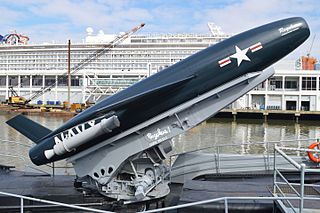 W
WThe SSM-N-8A Regulus or the Regulus I was a United States Navy-developed ship-and-submarine-launched, nuclear-capable turbojet-powered second generation cruise missile, deployed from 1955 to 1964. Its development was an outgrowth of U.S. Navy tests conducted with the German V-1 missile at Naval Air Station Point Mugu in California. Its barrel-shaped fuselage resembled that of numerous fighter aircraft designs of the era, but without a cockpit. Test articles of the Regulus were equipped with landing gear and could take off and land like an airplane. When the missiles were deployed they were launched from a rail launcher, and equipped with a pair of Aerojet JATO bottles on the aft end of the fuselage.
 W
WThe T249 Vigilante was a prototype 37 mm self-propelled anti-aircraft gun (SPAAG) designed as a replacement for the Bofors 40 mm gun and M42 Duster in US Army service. The system consisted of a 37 mm T250 six-barrel Gatling gun mounted on a lengthened M113 armored personnel carrier platform.
 W
WTitan was a family of United States expendable rockets used between 1959 and 2005. The Titan I and Titan II were part of the US Air Force's intercontinental ballistic missile fleet until 1987. The space launch vehicle versions contributed the majority of the 368 Titan launches, including all the Project Gemini crewed flights of the mid-1960s. Titan vehicles were also used to lift US military payloads as well as civilian agency reconnaissance satellites and to send interplanetary scientific probes throughout the Solar System.
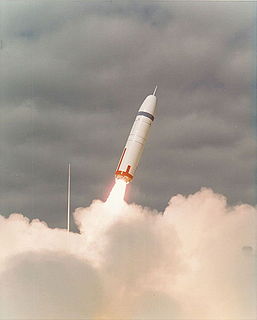 W
WThe Trident missile is a submarine-launched ballistic missile (SLBM) equipped with multiple independently targetable reentry vehicles (MIRV). Originally developed by Lockheed Missiles and Space Corporation, the missile is armed with thermonuclear warheads and is launched from nuclear-powered ballistic missile submarines (SSBNs). Trident missiles are carried by fourteen United States Navy Ohio-class submarines, with American warheads, as well as four Royal Navy Vanguard-class submarines, with British warheads. The missile is named after the mythological trident of Neptune.
 W
WThe UGM-73 Poseidon missile was the second US Navy nuclear-armed submarine-launched ballistic missile (SLBM) system, powered by a two-stage solid-fuel rocket. It succeeded the UGM-27 Polaris beginning in 1972, bringing major advances in warheads and accuracy. It was followed by Trident I in 1979, and Trident II in 1990.
 W
WThe UGM-96 Trident I, or Trident C4, was an American submarine-launched ballistic missile (SLBM), built by Lockheed Martin Space Systems in Sunnyvale, California. First deployed in 1979, the Trident I replaced the Poseidon missile. It was retired in 2005, having been replaced by the Trident II.
 W
WThe UGM-133A Trident II, or Trident D5 is a submarine-launched ballistic missile (SLBM), built by Lockheed Martin Space in Sunnyvale, California, and deployed with the American and British navies. It was first deployed in March 1990, and remains in service. The Trident II Strategic Weapons System is an improved SLBM with greater accuracy, payload, and range than the earlier Trident C-4. It is a key element of the U.S. strategic nuclear triad and strengthens U.S. strategic deterrence. The Trident II is considered to be a durable sea-based system capable of engaging many targets. It enhances the U.S. position in strategic arms negotiation with performance and payload flexibility that can accommodate active treaty initiatives. The Trident II's increased payload allows nuclear deterrence to be accomplished with fewer submarines, and its high accuracy—approaching that of land-based missiles—enables it to be used as a first strike weapon.
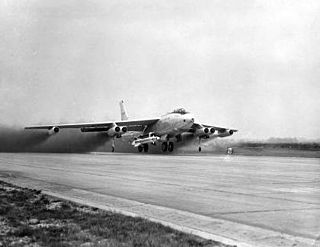 W
WWeapons System 199 (WS-199) was a weapons development program conducted by the United States Air Force to research and develop new strategic weapons systems for Strategic Air Command. Two air-launched and one ground-launched vehicles were developed as part of the program. While none entered production, they assisted in the development of both the GAM-87 Skybolt air-launched ballistic missile and that of re-entry vehicles for ballistic missiles.
 W
WThe Fairchild SM-73 was a sub-sonic, jet-powered, ground-launched decoy cruise missile.